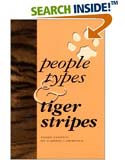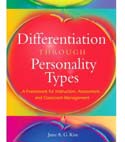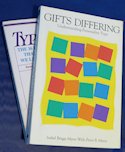
- About the MBTI
- Verify Your MBTI Type
- Personality Patterns
- MBTI Articles & Resources
- Article Directory for Educators & Students
- Books on Personality Types
- Emotional Intelligence & Personality Type
- Career Planning & MBTI
- MBTI Business Applications
- Lenore Thomson - Carl Jung Personality Type
- Site Map - Master Directory of All Articles
- MBTI Consultant Links
- Personality Type Workshops & Conferences
- Links to Other Type Websites
- Murder Mystery Business Theatre
- About Us
| 1 | 2 | 3 |
Articles on MBTI ® applications: Personality Type Applications in Education
Are They Really Problem Students? Bridging Differences through Understanding
By Jane Kise, Ed. D., and Beth Russell, Ed. D.
(jane kise' preferences are infj; beth russell's are enfj)
Page 3 . . .
Thinking and Feeling
Our preference for Thinking or Feeling describes how we make decisions. People with a preference for Thinking look for logical explanations, cause-effect or if-then arguments, and universal rules or truths. People with a preference for Feeling consider the impact a decision might have on the people involved. Thinking students often seem to enjoy arguments, while Feeling students have trouble functioning in classrooms where putdowns and other forms of disharmony are common.
|
An understanding of the difference between Thinking and Feeling often helps resolve conflicts. For example, a parent requested a meeting with the school principal because her daughter, who had gotten A’s in 7th grade English and liked to write, was barely doing C work in 8th grade English. The girl had said, “The teacher doesn't like me, so I’m not going to do the work.” In talking to the girl, the principal discovered that she had a preference for Feeling. The teacher had critiqued the girl’s writing without giving any specific praise, assuming that the student would interpret her comments as advice for making her excellent writing even better. When the principal reinterpreted the situation in terms of Thinking and Feeling, it gave the teacher and student a fresh start together.
Similarly, a Thinking teacher noted that a boy in her math class was visibly upset. When she asked what was wrong, he said, “I’ve had my hand up for 15 minutes and you haven’t called on me.” His hand had only been half-raised and she hadn’t seen it. Further, in her class, students regularly came to her desk for help.
The boy had tears in his eyes. She reminded him that she was a Thinker and he was a Feeler, then said, “Your feelings told you that I was ignoring you, but I wasn’t being mean, was I? This can’t get in the way of your math work.” As she was speaking, his face lit up. He understood.
Judging and Perceiving
This preference pair describes how we naturally approach life. Judging students seem to have built-in clocks and are able to plan out their work and work their plan. Perceiving students live more in the moment, taking a spontaneous approach to life. They are not lazy or irresponsible by nature. Instead, they understand that being flexible opens opportunities.
Our schools operate out of a Judging preference: think of schedules, due dates, quarterly grades, and class agendas. If Perceiving students aren’t introduced to planning methods that use their own strengths, they may begin to feel inadequate as deadline after deadline catches up with them.
Students with a preference for Judging often start working on assignments as soon as they receive them. They feel they can’t play until their work is done. Further, they seem to be able to estimate how long it will take them. If for some reason they have to wait until the last minute, they feel stressed in ways that inhibits both their creativity and their accuracy.
However, in their rush to finish, some Judging students may not gather enough information or consider alternative ways to complete a project. They can learn from Perceivers the benefits of staying open longer to new ideas.
Students with a preference for Perceiving do their best work under pressure. If they try to start early, they struggle to find ideas. As the time pressure builds, so does the quality of their efforts. However, they often underestimate how long a project will take. A student described one such incident: “Once I had a month to make a board game. I had ideas in my head, but I didn’t start until two days before the deadline. I worked all afternoon on it, then prepared my speech the next night. I got a B+ on it. If I’d started earlier I could have gotten an A.”
Perceiving students need different time management tools than Judging students. One of the most successful is teaching them to plan backward, helping them identify the steps involved in a project and then develop realistic time estimates for each step. How long will it take to make a board game? To buy the supplies? To plan out the rules? To narrow down the design choices? Answers to these questions provide the “real” last minute when they must start.
A Climate of Understanding
In the schools where we’ve worked together, nearly 80% of the students that teachers had labeled “at risk” because of either academic or behavior problems had preferences for Extraversion and Perceiving. We would suggest that perhaps school structures rather than these students are often the problem.
While students can learn to use their less-preferred personality preferences, it is easier for teachers to adjust their styles than for adolescents to adjust theirs! Our overarching goal in using type is to help students and teachers understand themselves and each other. As they develop a common vocabulary around their psychological preferences, one teacher observed that they seemed more tolerant of each other. Another said, “I was hesitant that kids would understand types, but they did and it was affirming—they weren’t defects. Now they say, ‘It’s not that I’m a bad student—I just need to work on certain skills.’
References
Lamphere, G. I. (1985) The relationship between teacher and student personality and its effects on teacher perception of students. Unpublished doctoral dissertation, United States International University.
Lipman, Pauline (1998). Race, class, and power in school restructuring. Albany, New York: State University Press of New York.
Dr. Jane Kise, Ed. D., infj, is an educational consultant and author who has used personality type to enhance learning and understanding in a variety of settings. Dr. Beth Russell, Ed. D., enfj, is Principal of Anwatin Middle School in Minneapolis, Minnesota. Visit www.janekise.com |
® MBTI, Myers-Briggs, Meyers Briggs, and Myers-Briggs Type Indicator are registered trademarks or trademarks of the Myers-Briggs Type Indicator Trust in the United States and other countries (aka meyers briggs or myers briggs).
 People Types and Tiger Stripes
People Types and Tiger Stripes
Gordon Lawrence's book is mandatory reading for any educator, teacher or trainer interested in using an understanding of Myers-Briggs Personality Type to improve their effectiveness. Because Lawrence practiced what he preached, this book is organized in a fashion that is easy read for "all personality types." it also does a nice job of including both introductory material on understanding Personality Types and extensive material on applications to the classroom and learning environment. It is jam packed full of useful advice. [Ordering Info Here]
© Published by Ross Reinhold & Reinhold Development 1997 - 2023
Privacy Policy About Us



